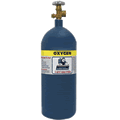|
Gases, involved in chemical reactions show simple ratios between gas volumes. This makes dealing with gaseous reactions very simple in terms of calculations. |

|
Gas molar volume
Avogadro realised that if gas volumes contain the same number of particles as one another (under the same temperature and pressure conditions) then an Avogadro number of molecules of each gas will occupy the same volume. This volume is called the gas molar volume
When the temperature is 273K and the pressure is 1 atmosphere (100.0 kPa) the gas molar volume is equal to 22.7 dm3 ( to 3 significant figures)
This means that the number of moles of a gas can be calculated from the volume, providing the temperature and the pressure are known.
It is important to be consistent with the volume units used. In the equation triangle above, the units are litres for all volume measurements..
|
Example: Calculate the number of moles of present in 10 dm3 of gas at STP 1 mole of gas occupies 22.7 dm3 at STP therefore moles of gas = volume (in litres) /22.7 Moles of gas = 10/22.7 Moles of gas = 0.441 moles |
If the conditions are not STP (standard temperature and pressure) then the ideal gas equation PV = nRT must be used to find the number of moles (see section 3.410).

